Welcome to a journey of culinary exploration! In this intriguing post titled “Exploring the Prickly Delights: Unveiling the Culinary World of Edible Cactus Plants,” we will dive deep into the fascinating realm of cacti, not just desert dwellers, but also delectable additions to our plates.
Have you ever wondered if those prickly, spiky plants could actually be edible? Prepare to satisfy your curiosity as we embark on an exciting adventure of discovering the hidden culinary treasures within the world of cacti.
In the next few paragraphs, we will unveil the answers to some burning questions. Ever wondered which cactus species are safe to consume? Curious about the flavors and textures they offer? Seeking insights into the nutritional benefits they provide? Look no further; we will address all these queries and more, leaving no stone unturned.
Why is it important to explore the realm of edible cacti, you may wonder? Well, in a world where innovative and sustainable food sources are gaining prominence, cacti present a unique opportunity. These resilient plants thrive in arid environments and offer a surprising array of flavors and nutrients that can tantalize our taste buds and nourish our bodies.
Join me on this adventure as we venture into the world of edible cactus plants. From identifying safe varieties to understanding how to prepare and cook them, we will delve into the diverse ways cacti can be incorporated into our culinary endeavors.
So, fasten your seatbelts and prepare for an immersive experience that will leave you with newfound knowledge and a desire to explore the untapped potential of these prickly delights. The time has come to unlock the secrets of edible cacti and savor their extraordinary flavors!
1. Prickly Pear Edible Cactus Plants
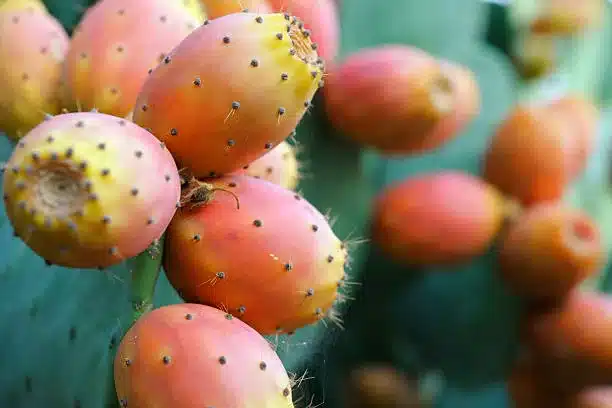
Today, I am thrilled to introduce you to the enchanting Prickly Pear Cactus, a true gem among edible cactus plants. Brace yourselves, for this is an experience you will want to experience!
When it comes to planting Prickly Pear Cacti, location is key. Picture this: vibrant landscapes bathed in sunlight, warm climates, and well-drained soil. These are the ideal conditions that allow this resilient beauty to thrive. So, if you’re lucky enough to reside in a region with a Mediterranean or desert-like climate, you’re in for a treat!
Now, let’s get to the juicy part—literally! The Prickly Pear Cactus offers a delightful bounty of flavors and textures. The vibrant, succulent fruits known as “prickly pears” or “tunas” are the show’s stars. They are a true delicacy, bursting with a harmonious blend of sweet and tangy notes. You can enjoy them raw, turned into refreshing juices, or even transformed into mouthwatering jams.
But that’s not all—the Prickly Pear Cactus has more tricks up its spiky sleeves! Its tender young pads, called “nopales,” are a versatile addition to your culinary repertoire. Sauteed, grilled, or added to salads, these nopales offer a delightful crunch and a slightly tangy flavor that will elevate your dishes to new heights.
Now is the time to seize the opportunity to explore the world of Prickly Pear Cacti. Don’t wait! Discover the joys of cultivating this exquisite plant in your garden, harnessing its resilience, and reaping the rewards of its delicious fruits and pads. Get ready to tantalize your taste buds with the wonders of the Prickly Pear Cactus—a culinary adventure like no other awaits you!
2. Barbary Fig Edible Cactus Plants

The magnificent Barbary Fig Cactus. Prepare to be captivated by its beauty and tantalized by its delectable offerings. Trust me; this is an opportunity you won’t want to miss!
When it comes to planting the Barbary Fig Cactus, location plays a pivotal role in its success. This resilient beauty thrives in arid and semi-arid regions, making it an ideal choice for those living in dry climates. The Barbary Fig craves abundant sunshine, so find a spot in your garden that basks in full sun exposure. As for the soil, this cactus prefers well-drained, sandy, or rocky soil to ensure optimal growth.
Now, let’s dive into this remarkable cactus’s culinary treasures. The ripe fruits of the Barbary Fig, also known as “prickly pears,” are a true delicacy. Bursting with a symphony of flavors, they are both sweet and subtly tangy, leaving your taste buds in a state of bliss. The Barbary Fig will elevate your culinary creations to new heights, whether enjoyed fresh, transformed into jams, or incorporated into desserts.
Time is of the essence! Don’t wait to embark on this tantalizing adventure with the Barbary Fig Cactus. The clock is ticking, and the flavors of this remarkable plant are calling out to be savored. Join me in exploring the wonders of edible cactus plants and unlock a world of extraordinary culinary delights. The Barbary Fig awaits you—seize the moment and indulge in its edible splendor today!
3. Organ Pipe Cactus

Now to introduce you to a true desert marvel—the Organ Pipe Cactus. Prepare to embark on an unforgettable journey into the world of edible cactus plants!
When it comes to planting the Organ Pipe Cactus, let me paint you a vivid picture of its ideal habitat. Imagine vast, arid landscapes with well-drained soil basking in the scorching sun. This cactus craves the warmth of the desert, thriving in USDA hardiness zones 9 to 11. So, if you’re lucky enough to call a desert or subtropical region home, you’re in for an extraordinary treat!
Now, let’s delve into the culinary wonders this remarkable cactus offers. The Organ Pipe Cactus provides a unique edible treat—its luscious, pear-shaped fruits. Bursting with a delightful blend of sweetness and tang, these succulent fruits can be enjoyed fresh, juiced, or transformed into heavenly jams and jellies. Each bite will transport you to the desert’s heart, savoring this remarkable plant’s essence.
But here’s the catch—the Organ Pipe Cactus is an endangered species, making it a rare and precious find. The urgency to explore and appreciate its edible qualities has never been greater. By cultivating and enjoying this plant responsibly, we can play a part in preserving its existence for generations to come.
So, my fellow adventurers, it’s time to take action! Unleash your inner desert explorer and embrace the extraordinary world of the Organ Pipe Cactus. Let its beauty, resilience, and delectable fruits ignite your passion for edible cactus plants. Together, let’s celebrate the desert’s flavors and contribute to preserving this remarkable species.
4. Dragon Fruit Edible Cactus Plants
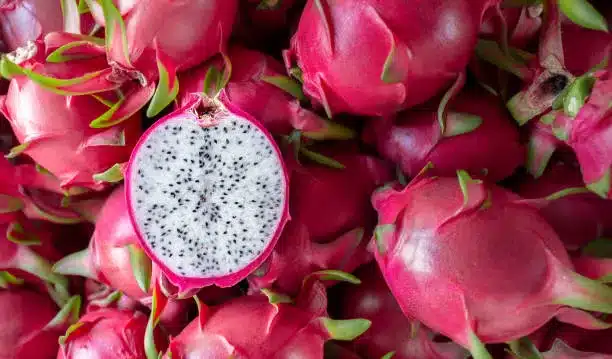
Greetings, fellow Epicurean explorers! Today, I am delighted to introduce you to the captivating Dragon Fruit Cactus, a mesmerizing specimen among edible cactus plants. Prepare to embark on a culinary adventure that will awaken your senses and leave you craving for more!
When it comes to planting Dragon Fruit Cacti, choosing the right location is vital. Seek out sun-kissed spots where these enchanting plants can bask in full sunlight. They thrive in warm climates, with temperatures around 65 to 90 degrees Fahrenheit (18 to 32 degrees Celsius). Well-drained soil is key, as excessive moisture can lead to root rot. So, find a location where water won’t accumulate, ensuring that your Dragon Fruit Cactus flourishes.
Now, let’s dive into the delightful culinary possibilities this captivating cactus offers. The show’s star is, of course, the Dragon Fruit itself. With its vibrant, exotic appearance and subtly sweet taste, this luscious fruit can be enjoyed fresh, sliced into tantalizing fruit salads, blended into vibrant smoothies, or even transformed into tantalizing sorbets.
What makes the Dragon Fruit truly captivating is its versatility. The mild, slightly nutty flavor and the delightful crunch of its seeds make it a wonderful addition to various dishes. From refreshing salsas to delectable desserts, this edible cactus plant knows how to leave a lasting impression on your palate.
So, fellow culinary adventurers, take advantage of the extraordinary Dragon Fruit Cactus! Embrace its stunning beauty and savor the delectable flavors it offers. Transform your garden into a paradise of edible cactus plants and indulge in the wonders of this captivating cactus. Unleash your creativity and let the Dragon Fruit transport you to a world of gastronomic enchantment. The time has come to embrace the extraordinary potential of these edible cactus plants and elevate your culinary escapades to new heights!
5. Saguaro Edible Cactus Plants

Saguaro Cactus—an edible cactus plant that will transport your taste buds to new heights! Get ready to embark on a flavorful journey like no other.
When it comes to planting the Saguaro Cactus, finding the ideal location is paramount. Imagine a place with abundant sunlight, well-drained soil, and a warm climate. This magnificent cactus thrives in arid and desert-like environments, soaking up the sun’s rays and showcasing its resilience. You’re in luck if you live in a region with these conditions! The Saguaro Cactus will flourish and reward you with its delectable offerings.
Now, let’s talk about the culinary wonders this edible cactus plant has in store for us. The Saguaro Cactus is truly versatile. Its juicy, succulent fruits, resembling plump berries, are a delight to behold and a treat to savor. Whether eaten fresh, used in jams, or blended into luscious smoothies, these fruits are bursting with unique flavors that will awaken your senses.
But that’s not all—the Saguaro Cactus has another secret to share. Its tender pads, known as “nopales,” are nutritious and incredibly versatile in the kitchen. Sauteed, grilled, or added to salads, these nopales offer a delightful crunch and a slightly tangy taste that will elevate your culinary creations to new heights.
Find the perfect spot, plant it carefully, and witness its magnificent growth. Let us unlock the flavors of this captivating edible cactus plant together and embark on a culinary adventure that will leave us yearning for more.
6. Echinocereus Edible Cactus Plants
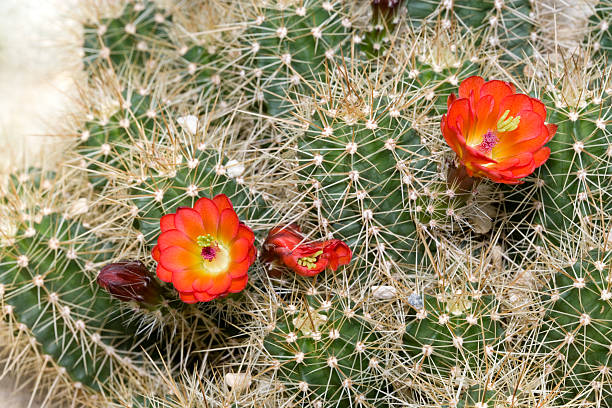
Echinocereus Cactus is a true marvel among its prickly counterparts.
When it comes to planting the Echinocereus Cactus, location is of utmost importance. Imagine a picturesque setting where the sun caresses the earth, and the temperatures are warm and inviting. Look for a spot with well-drained soil, preferably sandy or gravelly, as this cactus craves excellent drainage. Areas with low humidity and good air circulation are also ideal. So, if you’re fortunate enough to reside in arid regions or have a sunny garden with these conditions, you’re in for a treat!
Now, let’s uncover the delectable secrets of this magnificent cactus. While not all species of Echinocereus are edible, some offer delightful culinary possibilities. The vibrant, fleshy fruits, known as “hedgehog cactus fruits,” are a true delight. Bursting with sweetness and juiciness, they are perfect for eating fresh or incorporating into jams, jellies, and desserts. Additionally, some varieties of Echinocereus boast tender young pads that can be cooked and enjoyed as a nutritious vegetable.
With its captivating beauty and culinary potential, the Echinocereus Cactus is a treasure waiting to be discovered. Embrace the adventure of cultivating this exceptional plant, savoring its succulent fruits, and relishing the versatility of its tender pads. Unleash your inner explorer and delve into the world of edible cactus plants—your taste buds will thank you!
7. Peruvian Apple Cactus
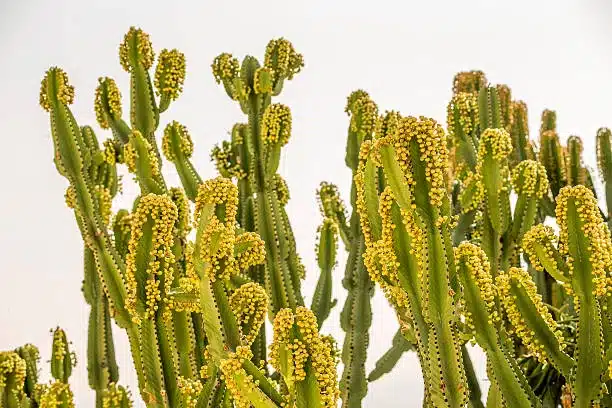
The Peruvian Apple Cactus. Brace yourself for an extraordinary journey through this marvelous plant’s vibrant flavors and remarkable versatility!
When it comes to planting the Peruvian Apple Cactus, location plays a pivotal role. Picture a place blessed with abundant sunlight, a warm climate, and well-drained soil. This cactus thrives in arid and semi-arid regions, making it an excellent choice for those of us living in dry climates. However, don’t fret if you reside in a different environment—this adaptable plant can also flourish in a sandy or loamy soil. Just ensure that it receives ample sunlight, preferably in a location with protection from strong winds.
Now, let’s savor the numerous ways you can indulge in the bounty of the Peruvian Apple Cactus. Its strikingly vibrant fruits, resembling the apples of our dreams, are a true feast for the senses. Slice them up and enjoy their sweet, refreshing flavor as a standalone snack, or use them to create mouthwatering desserts and jams that will tantalize your taste buds.
But wait, there’s more! The pads of the Peruvian Apple Cactus, known as “nopales,” offer a delightful addition to your culinary repertoire. Grilled to perfection, these tender pads provide a slightly tangy and succulent experience. Alternatively, you can sauté them with spices and other vegetables to create a delectable side dish bursting with flavors.
Take advantage of the opportunity to embrace the remarkable Peruvian Apple Cactus in your gastronomic adventures. With its adaptability and extraordinary flavors, it’s a gift that keeps on giving. So, let’s embark on this remarkable exploration of edible cactus plants and unlock the hidden wonders of the Peruvian Apple Cactus together!
8. The Jumping Cholla Cactus

Jumping Cholla Cactus, a marvel among edible cactus plants. Prepare for an extraordinary journey filled with intriguing flavors and remarkable resilience!
When it comes to planting the Jumping Cholla Cactus, it’s crucial to consider its ideal habitat. Imagine vast landscapes of arid regions bathed in abundant sunshine. These cacti thrive in well-drained soil, preferring sandy or gravelly compositions. Look for locations with minimal rainfall and excellent air circulation to ensure their optimal growth.
Now, let’s explore the culinary possibilities of the Jumping Cholla Cactus. First and foremost, it’s important to note that the young stems of this cactus, known as “nopales,” are the edible parts. With a tangy and slightly tart flavor, they lend themselves beautifully to various dishes. Slice them and sauté with onions and spices for a mouthwatering addition to tacos or salads. You can also grill them to add a smoky touch or boil them to reduce their acidity.
But here’s the engaging part—you must handle them cautiously! The name “Jumping Cholla” stems from the cactus’s ability to detach its spiny stems with minimal contact. This phenomenon adds an element of excitement (and carefulness!) to your culinary endeavors. So, gear up, grab your tongs, and be prepared for an adventure as you harvest and prepare these delectable nopales.
Let’s seize the opportunity to explore the intriguing world of the Jumping Cholla Cactus. Don’t be deterred by its spiky nature; dive into the realm of edible cactus plants and discover their wonders. Unleash your culinary creativity and savor the unique flavors that this remarkable cactus brings to the table. Embrace the adventure and unlock the extraordinary potential of the Jumping Cholla Cactus—a true delight for the daring palates among us.
9. Ferocactus Edible Cactus Plants
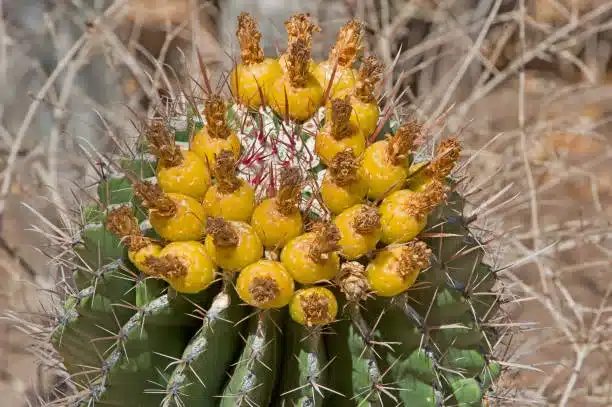
The fascinating Ferocactus is a truly remarkable member of the cactus family. Get ready to embark on a journey into the heart of this majestic plant!
When it comes to planting the Ferocactus, finding the perfect location is crucial. Imagine a sun-drenched landscape with sandy, well-drained soil. These arid environments, often found in desert regions, are the Ferocactus’s natural habitat. However, don’t fret if you don’t live in a desert! With proper care and attention, you can create a microcosm that replicates these ideal conditions right in your own garden.
Now, let’s delve into the captivating flavors this edible cactus offers. The Ferocactus boasts delectable fruits, known as “barrel fruits” or “candy barrels.” These mouthwatering delights are juicy, tangy, and slightly sweet, making them a perfect addition to fruit salads, smoothies, or even enjoyed on their own.
But here’s where it gets truly exciting! The Ferocactus also surprises us with its versatile uses. Its tender, young stems, referred to as “cactus arms,” can be harvested and prepared in various ways. They can be grilled to perfection, providing a delightful smoky flavor and a tender texture that will leave you craving more.
Now, the time has come to unlock the wonders of the Ferocactus. Discover the thrill of nurturing this resilient plant in your garden, bringing a touch of the desert into your own backyard.
Edible Catus Plants FAQs
Are All Cactus Safe To Eat?
No, not all cacti are safe to eat. While there are several species of edible cacti that offer culinary delights, it is crucial to exercise caution and proper identification before consuming any cactus. Some cacti may have toxic or harmful properties, including spines or chemicals that can cause adverse reactions if ingested.
It is recommended to only consume cacti that are known to be safe and have been traditionally used for culinary purposes. Prickly pears (Opuntia species) and certain varieties of barrel cacti (Ferocactus species) are among the commonly recognized edible cacti. These have a long history of safe consumption and offer delicious fruits or tender pads that can be enjoyed.
To ensure your safety, it is essential to educate yourself about the specific cactus species you intend to eat. Consult reliable sources, seek guidance from experts, or consider joining foraging groups where experienced individuals can provide valuable insights.
Remember, when it comes to consuming cacti, it is better to be safe than sorry. Exercise caution, do your research, and only indulge in cacti that are known to be safe and edible.
How Can You Tell If A Cactus Is Poisonous?
Determining if a cactus is poisonous requires careful observation and proper identification. Here are some factors to consider:
- Research: Familiarize yourself with the characteristics of different cactus species and their toxicity levels. Reliable botanical references, plant identification guides, or consulting with experts can provide valuable information.
- Spines and Glochids: Pay attention to the presence of spines and glochids (small, hair-like structures) on the cactus. Some toxic cacti have spines that are hooked, barbed, or covered in toxic substances. Avoid cacti with unusual or suspicious spines.
- Color and Appearance: Toxic cacti may exhibit unusual coloration, such as bright or unnatural hues, which can be a warning sign. Additionally, certain toxic cacti may have strange growth patterns, irregular shapes, or an overall unhealthy appearance.
- Research Traditional Use: Investigate the traditional uses of the cactus species in question. Edible cacti usually have a history of safe consumption by indigenous communities or have been widely recognized as culinary ingredients.
- Consult Experts: If you’re unsure about the identification or toxicity of a particular cactus, it is best to consult with botanists, horticulturists, or experienced foragers who have knowledge about cacti.
Remember, determining the toxicity of a cactus can be challenging, and misidentification can have severe consequences. It’s crucial to exercise caution, do thorough research, and seek expert advice when in doubt.
How Do You Prepare A Cactus To Eat?
Preparing a cactus to eat involves several steps to remove the spines, thorns, and any potential bitterness. Here’s a general guide on how to prepare a cactus, specifically the pads (nopales):
- Selecting the Nopales: Choose young, tender pads for the best texture and flavor. Look for pads that are firm and free from blemishes or discoloration.
- Cleaning the Pads: Using a pair of tongs, carefully hold the pad and use a sharp knife to remove the spines and thorns. Start by cutting off the edges and then scrape the surface of the pad to remove any remaining spines. Alternatively, you can singe the spines off by briefly passing the pad over an open flame. Be cautious not to overcook the pad during this process.
- Rinsing: Rinse the pads thoroughly under cold water to remove any debris or residual spines.
- Cooking Methods: Nopales can be cooked in various ways. Here are a few popular methods:
- Boiling: Cut the cleaned pads into desired shapes (strips, squares, or diced) and boil them in salted water for about 10-15 minutes until they turn tender. Drain the water before using or incorporating them into recipes.
- Sauteing: Cut the pads into strips and sauté them with olive oil or your preferred cooking oil, along with onions, garlic, and other seasonings, until they soften and turn slightly golden.
- Grilling: Brush the cleaned pads with oil and grill them over medium heat until they are lightly charred and tender.
- Incorporating into Recipes: Once cooked, nopales can be used in various dishes such as salads, tacos, stir-fries, omelets, or even as a side dish. They add a unique texture and a slightly tangy flavor to the recipes they are added to.
Remember, cooking times may vary depending on the size and thickness of the nopales, so it’s important to keep an eye on them to avoid overcooking.
Whether you choose to boil, sauté, or grill, the preparation methods allow you to unlock the culinary potential of cactus pads and enjoy their delightful taste in your favorite dishes.
See the AWESOME video below (Less than 2 minutes) on preparing your cactus to eat:
Why Shouldn’t You Touch A Cactus?
It is generally advised to avoid touching a cactus, especially the spines or thorns, due to the following reasons:
- Prickly Defense Mechanism: Cacti have evolved spines or thorns as a defense mechanism against potential threats. These spines serve to deter animals or humans from touching or consuming the plant. They can be sharp, barbed, or covered in tiny, hair-like glochids, which can cause physical injury and discomfort if they come into contact with the skin.
- Irritation and Allergic Reactions: Some cactus spines or glochids have microscopic barbs or hooks that make them difficult to remove once embedded in the skin. This can lead to irritation, redness, swelling, and sometimes allergic reactions. The severity of the reaction may vary depending on the individual’s sensitivity and the specific cactus species.
- Toxicity: Certain cactus species may have toxic or irritating substances present in their spines or sap. Direct contact with these substances can cause skin irritation, allergic reactions, or other adverse effects. It is crucial to exercise caution and avoid contact with unknown cactus species, especially if you are not familiar with their potential toxicity.
To minimize the risk of injury or discomfort, it is best to admire cacti from a distance and avoid touching them directly. If you need to handle a cactus for any reason, it is advisable to wear protective gloves or use specialized tools designed for cactus handling.
Remember, safety is paramount when interacting with cacti or any spiky plants. Appreciate their beauty but keep a respectful distance to avoid unnecessary harm.
Will Raw Cactus Make You Sick?
In general, raw cactus, specifically the edible parts such as the pads (nopales) or fruits, is safe to consume if it comes from a known and recognized edible cactus species. However, there are a few considerations to keep in mind:
- Spines and Glochids: Raw cactus pads or fruits may still have residual spines or glochids, which can cause physical irritation or discomfort if consumed. It’s crucial to ensure proper cleaning and removal of these spines before consuming raw cactus.
- Bitterness: Some cactus species, particularly certain varieties of nopales, may have a natural bitterness. Eating raw nopales without any preparation or cooking can result in an unpleasant taste due to this bitterness.
To enjoy raw cactus safely and enhance its flavor, it is recommended to follow these steps:
- Cleaning: Thoroughly clean the cactus pads or fruits by removing spines, thorns, or glochids using gloves and a sharp knife.
- Removing Bitterness: To minimize the bitterness, you can blanch the cactus pads in boiling water for a few minutes, then drain and rinse them in cold water.
- Incorporating into Recipes: Once cleaned and prepared, you can incorporate raw cactus into various dishes. Raw cactus pads can be sliced and added to salads, salsas, or other fresh preparations. Raw cactus fruits can be peeled and eaten on their own or used in smoothies, jams, or desserts.
It’s important to note that individual sensitivities and allergies can vary, so if you have any concerns or experience adverse reactions after consuming raw cactus, it is advisable to consult a medical professional.
The Final Spine On Edible Cactus Plants
As I conclude this exciting journey through the culinary world of edible cactus plants, I am brimming with enthusiasm and a burning desire to share one last plea with you: Try them! Don’t let these prickly delights remain a mystery any longer.
Imagine the thrill of stepping into uncharted territory, venturing beyond the ordinary, and embracing the extraordinary. The flavors, textures, and nutritional benefits that cacti bring to the table are simply too enticing to resist. From the vibrant, juicy prickly pears to the versatile and tender nopales, each cactus offers a unique experience for your taste buds.
By embracing these edible wonders, you embark on a gastronomic adventure and contribute to sustainability and innovation in the culinary world. Cacti are resilient, sustainable, and abundant in arid environments, making them a perfect choice for forward-thinking food enthusiasts.
So, my dear readers, I implore you to take that leap of faith. Incorporate edible cactus plants into your culinary repertoire. Experiment with new flavors, surprise your guests with tantalizing dishes and explore the possibilities that lie within these remarkable plants.
Join me in savoring the flavors of the desert, embracing the unknown, and discovering the endless potential of edible cactus plants. Let us be pioneers in this culinary exploration, united by our shared love for extraordinary flavors and sustainable choices. Together, let’s unveil the secrets of these prickly delights and embark on a delectable journey like no other.

Hi there, I’m Mark Apletree, a gardening enthusiast with a passion for gardening, and gardening tools. I’ll be your go-to guide for all things related to gardening. The purpose of this website is to assist you in selecting the most suitable garden gear that meets your specific requirements.
See All Posts

